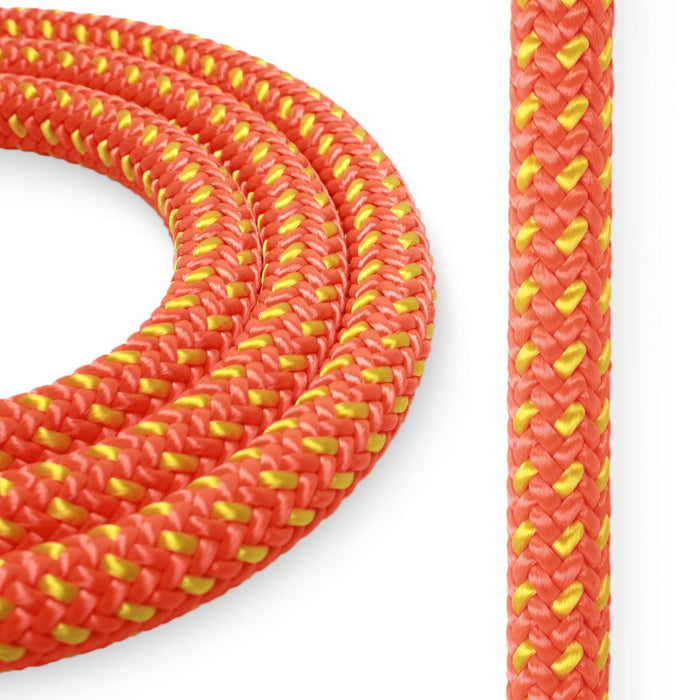
Tachyon Orange/Yellow
Weight: 0.07 lb

Revolutionary Flexifirm Core Technology results in a lightweight 11.5mm climbing line that stays firm and round while permitting spliced eyes in one or both ends of the line using a double braid splice. Tachyon performs well in popular hardware designed for use with 11mm ropes. The product's firm yet flexible design and superior strand definition significantly improve friction hitch performance without the "bagginess" that occurs with other 11mm ropes. The firm, round cross section also improves grip for less hand fatigue without the added bulk and weight of half inch ropes.
Features:
| Strand Count: | 24 Strands |
| Color: | Orange & Yellow |
| Diameter: | 11.5mm (7/16") |
| Weight: | 7.1lbs per 100ft. |
| Tensile Strength: | 7,100lbs (3,220kg) |
| Fiber: | Polyester over Polyamide |
Wherever possible, use splices constructed to safe specifications. A proper splice on a rope can maintain 80% to 100% of the new rope average break strength. Trained personnel should construct all splices. If knots are used on a rope, be aware that they can reduce the rope's strength by up to 50%. If knots are required, be sure to select the proper knot for the job.
All rope has a rating referred to as a "tensile strength" or "average break strength." This number is the amount of weight that the rope should be able to hold in ideal conditions, specifically, a new rope, with no knots or splices, at room temperature. These break strength numbers are based on actual destructive break testing by the manufacturer or a certified third-party testing facility. Ropes are tested over many cycles and the average break strength is determined and specified for the product. We test our ropes personally, and all our splicers have their work tested on an ongoing basis using a certified test bed facility. This is to ensure that their splicing work is perfect, and that their splicing technique and skills are 100% within acceptable splicing guidelines set by the rope industry. Even the best splices and best rope can break if overloaded or used improperly. Make sure you thoroughly understand what you are doing with a rope. Get the right rope for the right job. If you have questions or are even remotely unsure or have doubts. STOP and get the information you need to BE SURE you are doing things safely.
Rope wear, knots, extreme hot or cold temperatures, chemicals, the manner in which the load is applied and other factors will result in a break strength lower than the stated average break strength.
A rope with a stated or advertised break strength, in pounds will not necessarily safely hold something that weighs that amount! Refer to the SAFE WORKING LOAD of a specific rope for more information.
IF IN DOUBT, ASK A PROFESSIONAL. We get calls all the time from people who have questions about what is the best rope to use for any given application. Don't be afraid to ask. Ultimately YOU are responsible for your safety using ANY rope, so don't chance it.
In a broad generalization, most working loads vary from 1/10 to 1/4 of the average break strength of the rope. Applications for rope used in life support or personal fall protection environments must use the 1/10 ratio.